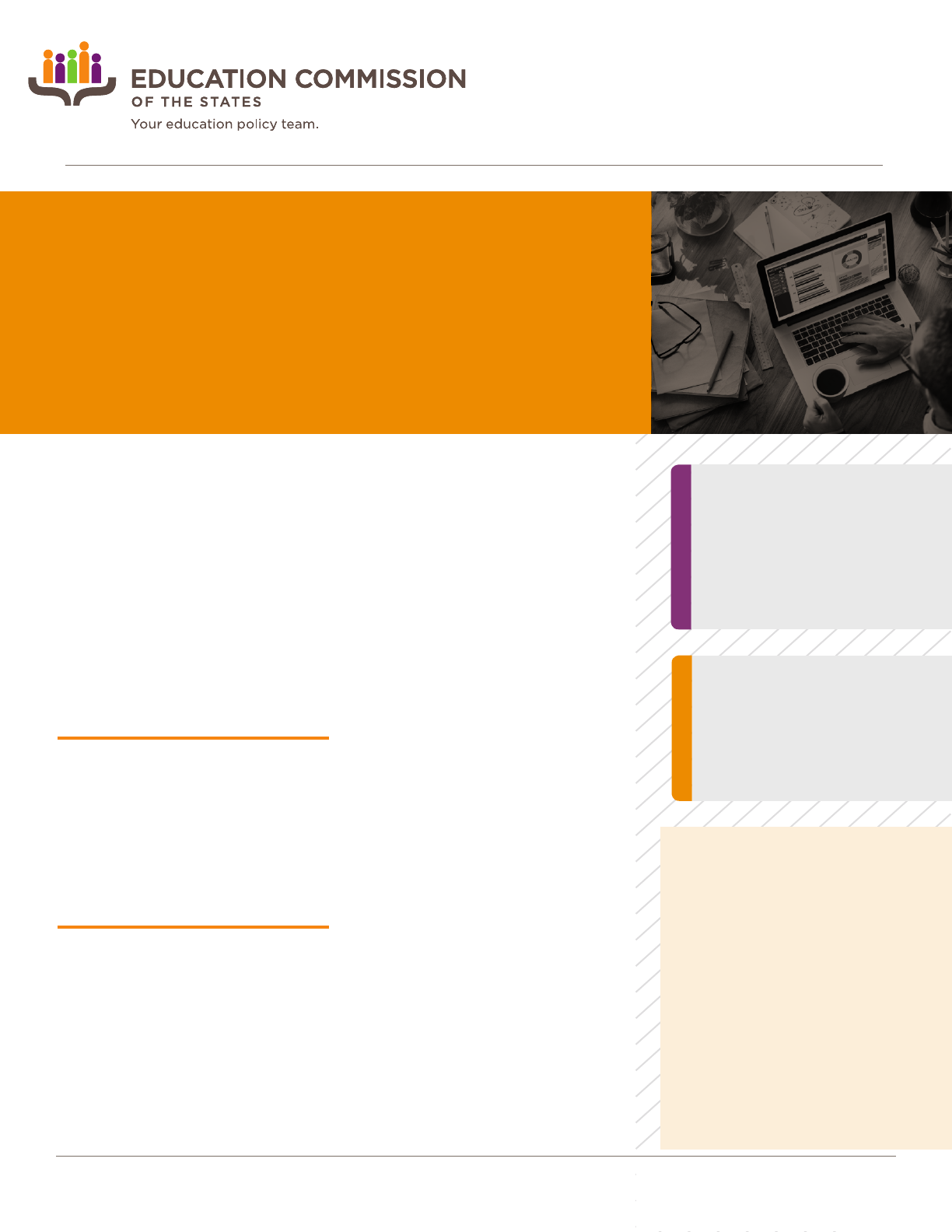
NOV 2016
www.ecs.org | @EdCommission
Many see education as the key to
future opportunity and success for
children of all backgrounds. However,
deeply entrenched inequities can
obstruct future opportunities and
successes for many American Indian
and Alaska Native students (hereafter
referred to as Native students).
2
These inequities are apparent in the
substantial achievement gap
that exists between Native students
and their white peers. On national
reading and mathematics exams,
Native students perform two to
three grade levels below their white
peers.
3
Additionally, Native students
face myriad diculties outside of
the classroom, including high levels
of poverty and challenges with both
physical and mental wellness.
Despite these problems, opportunities
exist for action that could positively
impact educational outcomes for
Native students. This report provides
an overview of the major education
issues the Native student population
faces and the current policies that exist
to address those issues at the federal
and state levels.
ESSA provides new
opportunities for states to
consider when enacting
legislation aecting Native
students.
Native students perform
well below their white
peers on national reading
and mathematics exams.
1
State and Federal Policy:
Native American youth
ALYSSA RAFA
POLICY
ANALYSIS
FOCUS IN.
Study up
on important
education policies.
ONLY 8 PERCENT OF
NATIVE STUDENTS ATTEND
FEDERALLY RUN SCHOOLS
THROUGH THE BUREAU OF
INDIAN EDUCATION, WHILE
THE REMAINING 92 PERCENT
ATTEND PUBLIC SCHOOLS.
Related Education Commission
of the States reports:
State and Federal Policy:
HOMELESS YOUTH
State and Federal Policy:
MILITARY YOUTH
State and Federal Policy:
INCARCERATED YOUTH
State and Federal Policy:
GIFTED AND TALENTED YOUTH
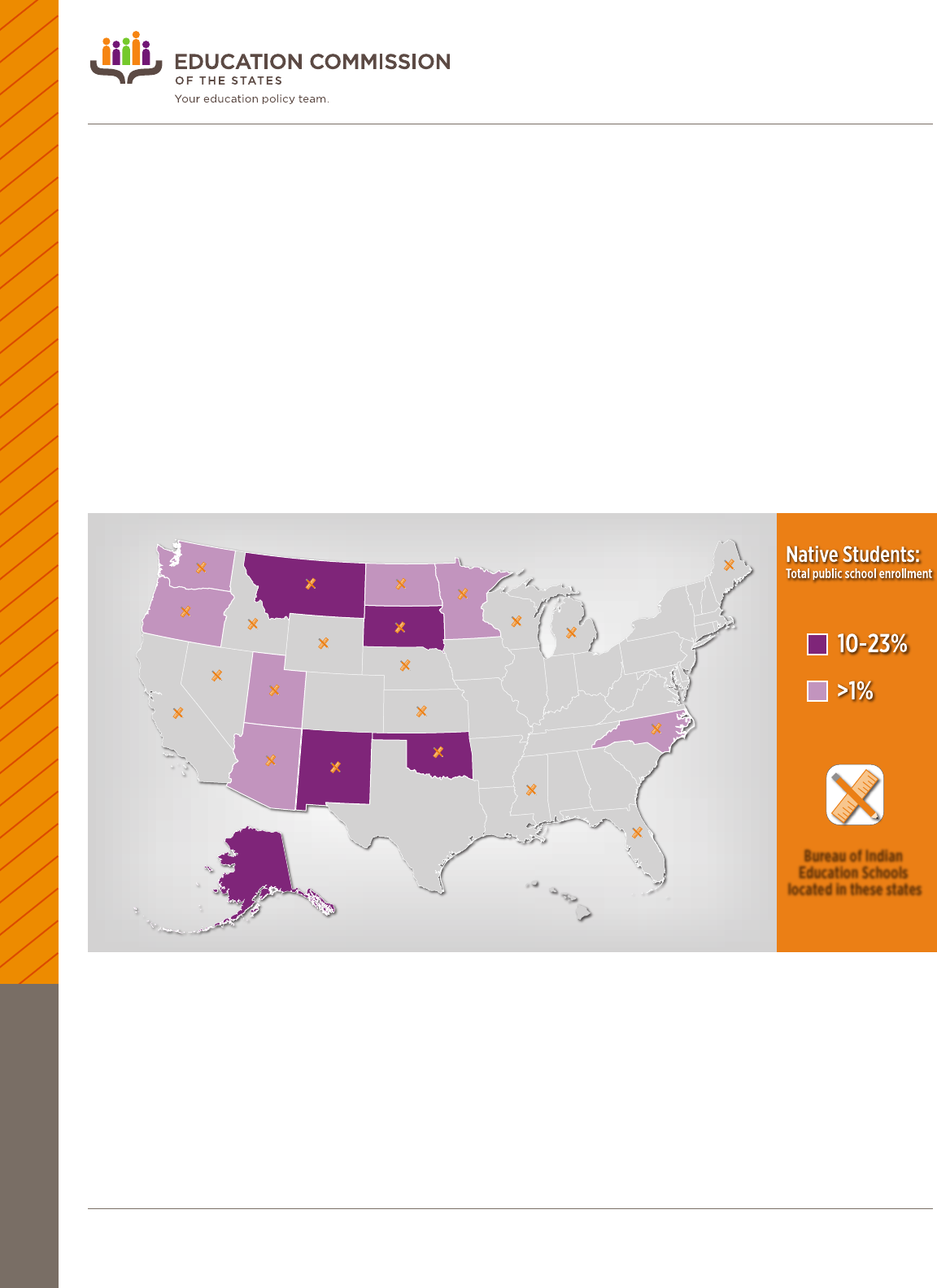
2
POLICY ANALYSIS
www.ecs.org | @EdCommission
Who are Native Students?
The federal government defines Native students as “a member or descendent of an Indian tribe or band, or
an Eskimo, Aleut, or other Alaska Native.”
4
Native students comprise about 1 percent of the national student
population. The Bureau of Indian Education (BIE),
5
the federal entity charged with providing education
opportunities to Native students, currently oversees 183 elementary and secondary schools on 64 reservations in
23 states, serving a total of approximately 41,000 students.
6
However, in recent years, this number represented only
8 percent of the total Native student population. The remaining 92 percent are educated within the public school
system.
7
Of those students attending public schools, more than 50 percent attend low-density public schools, or
schools where less than 25 percent of the students are Native students.
8
Significant regional dierences in where Native students attend school also exist. The vast majority of Native
students reside in 12 states, with the largest concentration of Native students in Alaska, Oklahoma, Montana, New
Mexico and South Dakota.
9
In these five states, Native students represent between 10-23 percent of the total
elementary and secondary school enrollment.
10
Bureau of Indian
Education Schools
located in these states
Education Challenges for Native Students
From diculties with school readiness to struggles with graduation, Native students face many challenges. Data on
educational outcomes demonstrate disparities between Native students and their non-Native peers. In 2011, just 22
percent of Native fourth graders scored at proficient or advanced levels in mathematics on the National Assessment
of Educational Progress (NAEP), compared to the national average of 40 percent.
11
Reading performance on the
NAEP improved for every other major ethnic group between 2005-2011, but Native students saw no such gain.
12

3
POLICY ANALYSIS
www.ecs.org | @EdCommission
Perhaps most startling is the Native student high school graduation rate
which, at 67 percent in public schools and 53 percent in BIE schools, is far
lower than the national average of 80 percent.
13
FIGURE 1: GRADUATION RATES
53%
Native Students
in BIE Schools
80%
U.S. National
Average
67%
Native Students
in Public Schools
In addition to disparities in educational attainment, Native students
often face extreme poverty, as well as physical and mental health issues.
According to a 2014 report issued by the White House, more than one in
three Native children live in poverty, and suicide rates among 15-24-year-
old Native youths are 2.5 times the national rate.
14
States that are considering enacting policies geared toward addressing
these educational disparities should be aware of the significant issues
facing this population. The aforementioned White House report also
outlined some of the key factors associated with these disparities.
15
Those
key factors include lack of genuine tribal control, challenges in recruiting
and retaining highly eective teachers and school leaders, and lack of
Native languages and cultures in schools. Since the vast majority of Native
students attend public schools, it is important that policymakers consider
both state-level options for policy action, as well as the guidance,
programs and funding provided by the federal government under the
Every Student Succeeds Act (ESSA).
Approximately 8 percent of Native
students attend schools administered
by the BIE, under the U.S. Department
of the Interior. The U.S. Department
of the Interior is in the process of
re-designing the BIE, as they attempt
to shift it from a direct provider of
education to a capacity-builder and
service-provider to tribes with BIE
funded schools.
18
The U.S. Department
of the Interior set several goals for
this re-design, including strengthening
and supporting the eorts of
tribal nations to directly operate
schools funded by BIE, recruiting
and retaining highly eective
teachers and principals in those
schools, and fostering partnerships
between parents, communities and
organizations.
19
Under ESSA, the BIE can determine
whether the requirements established
by the U.S. Secretary of Interior
for standards, assessments and
accountability are appropriate for
their students. The BIE may apply for
a waiver and submit a proposal for
alternative standards, assessments
and/or accountability systems.
20
Additionally, BIE is now eligible
for discretionary funding that was
previously only available to states,
including grant programs for arts
education, community schools and
prevention and intervention programs
for at-risk youth.
21
BUREAU OF
INDIAN EDUCATION
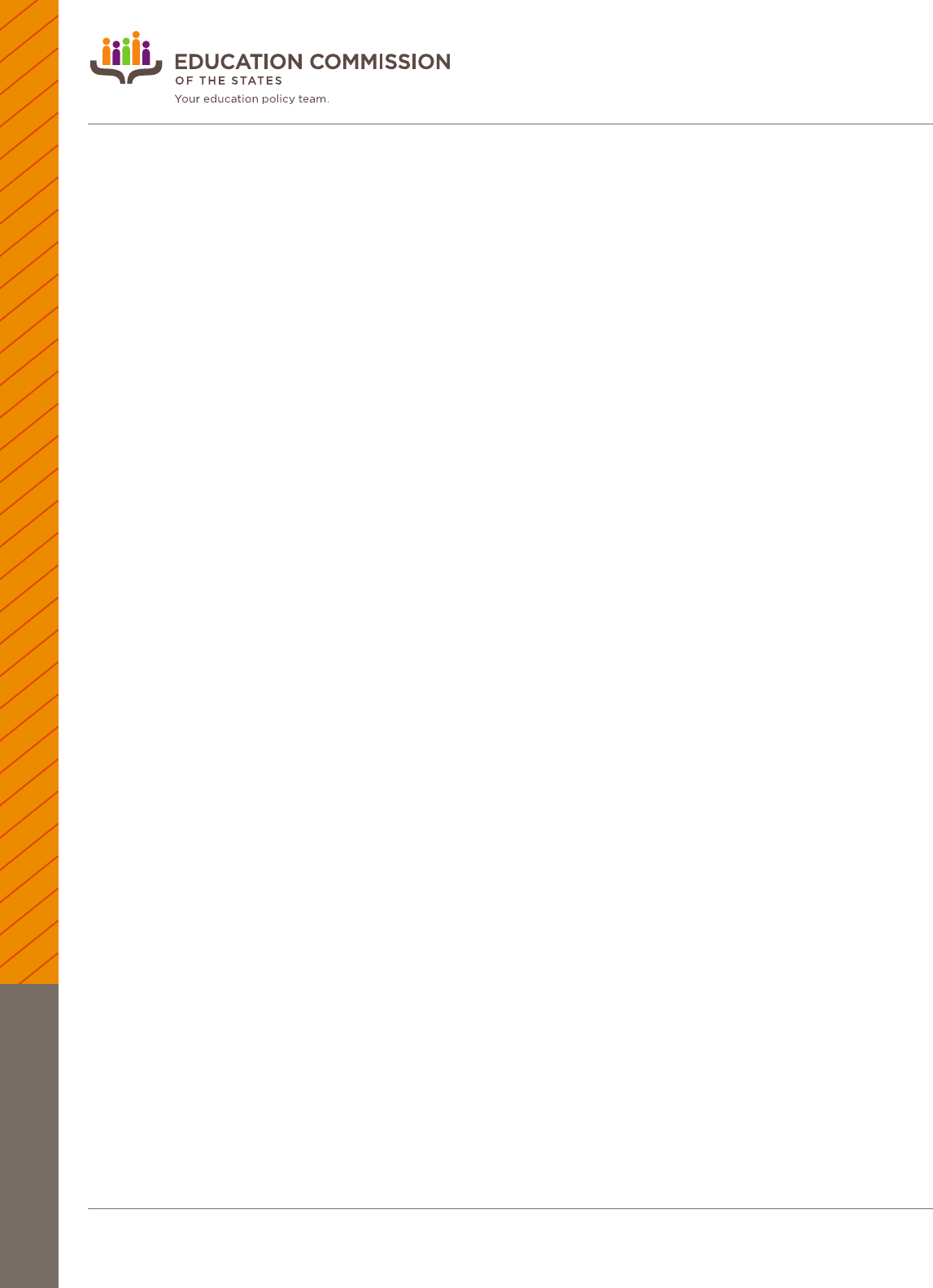
4
POLICY ANALYSIS
www.ecs.org | @EdCommission
Federal Guidance under ESSA
Under the “Federal Government’s unique and continuing trust relationship with…the Indian people,”
16
the United
States government is responsible for the education of Native students. Title VI of ESSA provides further guidance,
with the aim of ensuring that Native students have access to high-quality programs that provide for basic
elementary and secondary needs as well as unique, culturally related academic needs.
17
While the federal government provides education to a small percentage of Native students through the BIE,
the responsibility to educate Native students does not lie solely on federally run schools. ESSA includes several
provisions that provide states with opportunities to improve educational outcomes for Native students. These
provisions include mandated tribal consultation, cooperative agreements, the permanence of the State Tribal
Education Partnership (STEP) and increased opportunities to institute Native language immersion programs.
Meaningful Consultation
Among other purposes, the “meaningful consultation”
22
provision of ESSA is intended to improve collaboration
between the entities invested in providing high-quality educational experiences to Native students. When
developing state plans for Title I funding, ESSA requires states to engage in meaningful consultation with tribes in
a timely manner. Additionally, local education agencies (LEAs) are required to consult with tribal education leaders
in their areas before submitting a plan or application for a covered program under ESSA or under Title VI. To ensure
compliance, tribes or tribal organizations must sign a written armation that consultation has occurred.
Cooperative Agreements
Under ESSA, states must coordinate with tribes in their eorts to support the education of Native students. The
“cooperative agreements”
23
provision of ESSA authorizes LEAs to enter into cooperative agreements with tribes
that represent at least 25 percent of that LEA’s Native student population. Additionally, other entities, including
tribes, are now eligible to apply for Title VI (Native American Education) funding originally intended for LEAs if the
LEA fails to establish a committee for the grant.
State Tribal Education Partnership
In order to promote expanded tribal control over the education of Native students, ESSA authorizes coordination
and collaboration of tribal education agencies (TEAs) with state education agencies (SEAs) through the STEP
program. Prior to the passage of ESSA, STEP was a pilot program. This program provides an opportunity for tribes
to develop a TEA through a one-time, one-year funding opportunity.
Native Language Immersion
ESSA provides federal grant funding in an eort to support the use, practice and maintenance of Native American
and Alaska Native languages. States may use grant funding for a number of purposes, including providing
professional development for teachers and sta, refining or developing curriculum and creating or refining
assessments written in the specific language of instruction. Through ESSA, tribes, TEAs, LEAs and BIE schools
are all eligible for grants, among other entities. Additionally, ESSA authorizes a study, to be conducted by the U.S.
Secretary of Education in collaboration with the U.S. Secretary of the Interior, to evaluate several factors related to
Native language education in schools and programs. The study will focus on the use of Native American languages

5
POLICY ANALYSIS
www.ecs.org | @EdCommission
to provide instruction, the assessment of academic proficiency in
Native languages, the level of expertise and experience available
within schools and student outcomes, including graduation rates.
State Policy Examples
Several states have enacted legislation aimed at improving the
education of Native students in their schools. Those policies generally
fall into four categories: collaboration between state and tribal entities,
teacher recruitment and retention, Native language instruction and
culturally relevant curriculum. Generally speaking, those states with
larger Native student populations tend to legislate more actively in
this area of policy.
24
As such, many of the examples below reference
legislation in those states.
Tribal-State Collaboration
In order to eectively serve Native students, and to comply with ESSA
requirements, it is important for state education leaders to consult
with tribal education leaders during their decision-making processes.
In recent years, several states have enacted legislation aimed at
improving collaborative eorts. State policies around tribal-state collaboration usually create venues, such as oces
and commissions, to facilitate the progress of this work.
J Utah created the American Indian/Alaska Native public education liaison position as a member of the
team supporting the superintendent of public instruction. The liaison and members of various tribes and
nations located in Utah are members of the American Indian/Alaska Native Education Commission, which is
charged with creating the American Indian/Alaska Native education state plan to address the educational
achievement gap and meet the educational needs of Native students in the state.
25
J Washington created an Indian education division, known as the Oce of Native Education, within the oce
of the superintendent of public instruction. The oce provides assistance to school districts to meet the
educational needs of American Indian/Alaska Native students.
26
J Through state legislation, Arizona authorized the creation of an Oce of Indian Education, as well as a
state Commission on Indian Aairs.
27
Those entities have subsequently been established by the Arizona
Department of Education.
Teacher Recruitment, Training and Retention
Research consistently shows that student achievement is greatly impacted by the quality of a student’s teacher.
28
Unfortunately, there are marked diculties with recruiting and retaining high-quality teachers in isolated rural areas,
which tend to contain underperforming schools and oer low rates of compensation.
29
These diculties greatly
impact Native students, as almost half of Native students attend schools in rural locations.
30
Several states have
enacted policies aimed at addressing these issues, which incorporate strategies for tuition assistance, specialized
credential programs and professional development.
CURIOUS ABOUT
COLLABORATION?
Below are a few documents intended to
guide collaborative eorts between state
and tribal leaders:
J National Conference of
State Legislatures: Models of
Cooperation Between States and
Tribes
J Tribal State Partnerships:
Cooperating to Improve Indian
Education
J Montana: Tribal Relations
Handbook—A Guide for State
Employees on Preserving the
State-Tribal Relationship

6
POLICY ANALYSIS
www.ecs.org | @EdCommission
Funding of Native Student Programs
Programs that specifically address the educational needs of Native students are generally funded
through one of three sources: BIE funding, the Indian Education Fund (IEF) and funds allocated by
individual states.
Bureau of Indian Education Funding
In fiscal year 2015-16, the BIE provided $553.5 million ($13,401 per student)
for the operation of tribal schools (those schools administered by tribes or by
the BIE).
43
In addition, the BIE provided $134.2 million ($3,251 per student) to
tribal schools for facilities maintenance and operations. These tribal schools are
also entitled to receive all of the federal funding allocated to traditional public
schools, including funding for low-income students (Title I), teacher/principle
training and recruitment (Title II) and special education (Individuals with
Disabilities Education Act).
Indian Education Fund
In fiscal year 2015-16, the U.S. Department of Education provided $143.9
million to educate Native students through IEF.
44
The IEF provides grants to
both traditional public schools and to tribal schools, with the grants averaging
approximately $300 per student. In fiscal year 2015-16 the U.S. Department of
Education also provided $33.4 million for Native Hawaiian students and $32.5
million for Alaskan Native students.
State Funding for Native Students
A 2013 study found that most states do not provide additional funding for either
tribal schools or for Native students attending traditional schools.
45
However,
Maine does provide additional funding for tribal schools in the state. Under
the Maine Indian Claims Settlement Act of 1980, the state must provide tribal
schools with state funding above the amount of funding provided by the federal
government. Currently, the state has three K-8 tribal schools that receive state
funding. In addition, the state provides funding to students in ninth-12th grade
that can be used as voucher to attend the public high schools of their choice. In
the 2013 school year, the state’s three tribal schools received between $27,706-
$34,744 in total state funding per pupil. This compares to the state average
expenditure per student in fiscal year 2013 of more than $12,000.
46
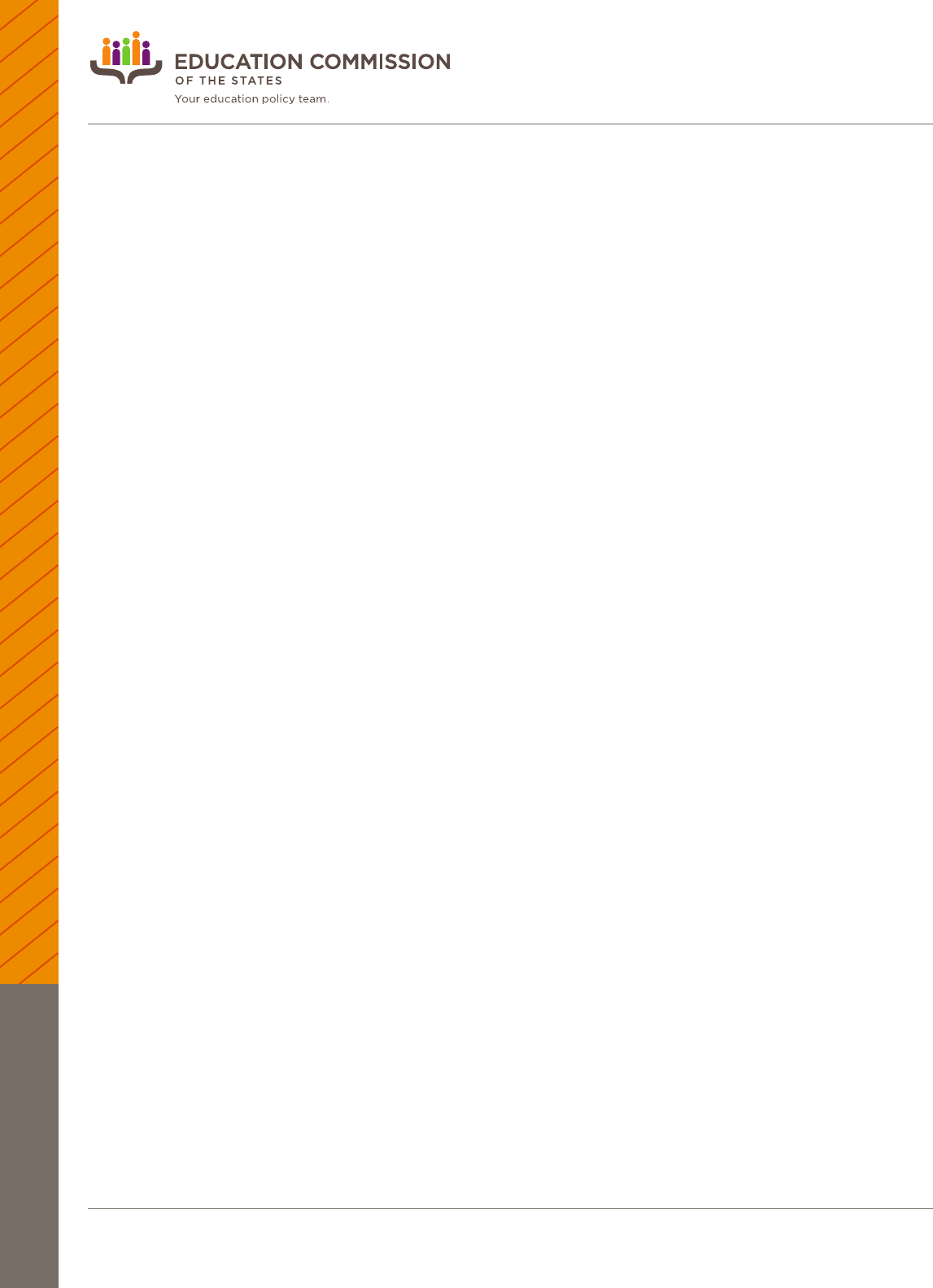
7
POLICY ANALYSIS
www.ecs.org | @EdCommission
J South Dakota established a paraprofessional tuition assistance scholarship program, which will
be administered by the Oce of Indian Education. The 2016 bill creating the program supports
paraprofessionals employed by qualifying schools serving Native students as they pursue full teacher
certification.
31
J California requires the Commission on Teacher Credentialing to issue an American Indian language-culture
credential – with an American Indian language authorization, an American Indian culture authorization,
or both – to any teacher candidate who has met specified requirements.
32
The state authorizes credential
holders to teach in preschool, K-12 and adult education.
J In 2016, Utah created the American Indian and Alaskan Native State Plan Pilot Program, a five-year
initiative to provide grants to districts and charter schools to fund recruitment, retention and professional
development for teachers in schools with high concentrations of Native students.
33
Native Language Programs
While many factors impact student success, research suggests that culturally responsive schooling, including
indigenous language instruction, increases academic achievement of Native students.
34
Many states provide for
Native language education in their state laws, including funding immersion programs and language revitalization
grants.
J In 2015, Montana enacted legislation encouraging school districts to create Indian language immersion
programs. The bill also provided one-time funding to support districts.
35
J Oklahoma recognizes Native American languages as a language art, authorizes the teaching of Native
American languages in public schools, allows Native American language courses to count as fulfilling core
requirements, and allows qualified teachers to teach Native American languages.
36
J In 2012, Alaska established the Alaska Native Language Preservation Advisory Council to advise both the
governor and legislature on programs, policies and projects to provide for the cost-eective preservation,
restoration and revitalization of Alaska Native languages.
37
J In 2009, Wisconsin passed a bill permitting a school board or cooperative educational service agency, in
conjunction with a tribal education authority, to apply to the state department of education for a Tribal
Language Revitalization Grant. These grants are intended to support innovative, eective instruction in one
or more American Indian languages.
38
Culturally Relevant Curriculum
In addition to the practice of Native languages, culturally relevant curriculum that emphasizes the traditional
characteristics of each community has also been associated with Native student academic achievement.
39
Several
states require the incorporation of Native American history and other culturally relevant curriculum into their
lessons.
J Washington requires its public schools to teach the state’s tribal history, culture and government.
40
While
the state requires school districts to use curriculum developed by the oce of the superintendent of public
instruction, they are also authorized to modify the curriculum in order to incorporate elements that have a
regionally specific focus or to incorporate culturally relevant curriculum into existing materials.
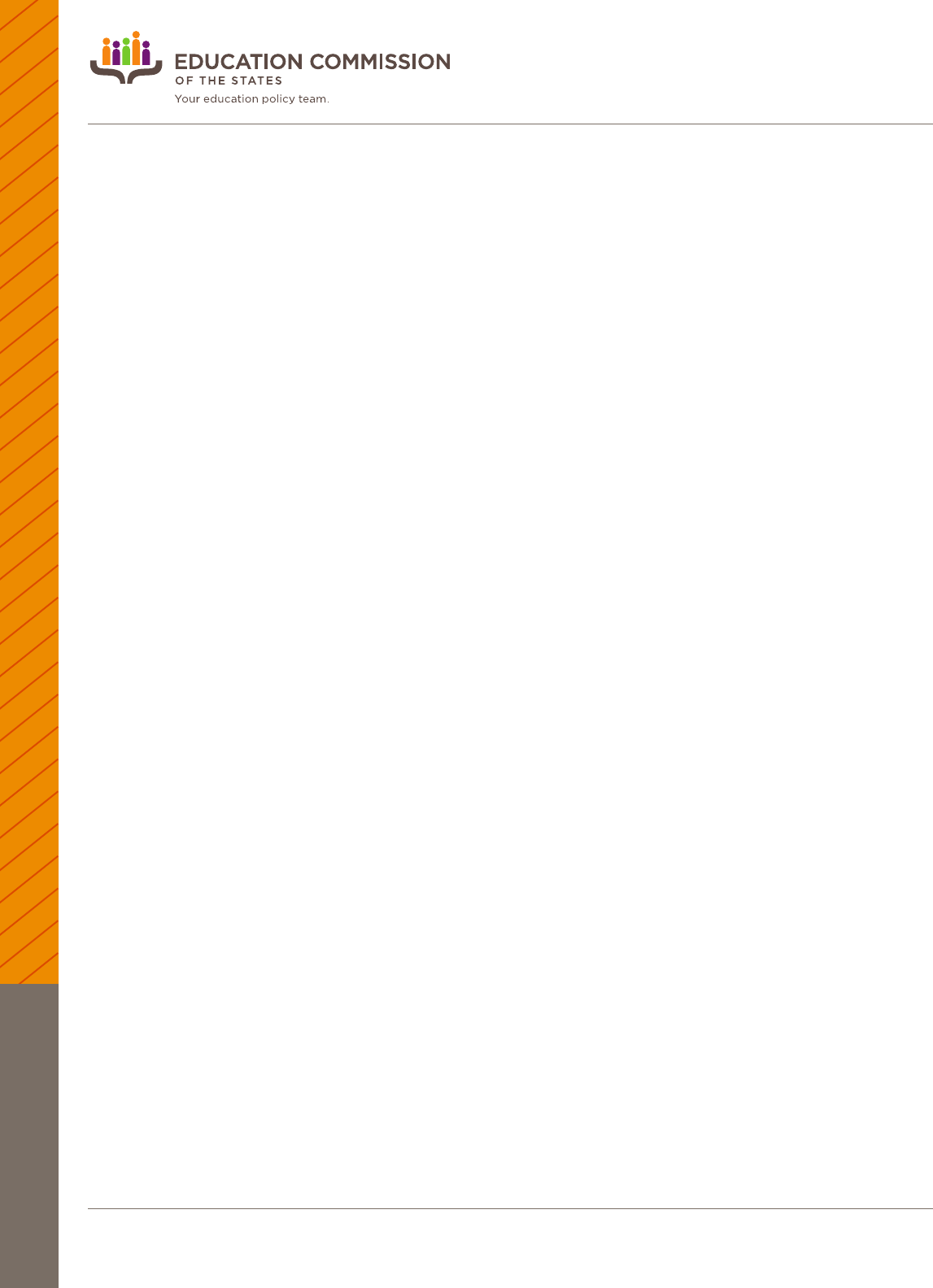
8
POLICY ANALYSIS
www.ecs.org | @EdCommission
J New Mexico requires its Indian Education Division to develop or select culturally relevant curriculum for
Native students in kindergarten through sixth grade that specifically prepares them for pre-advanced
placement and advanced placement coursework in seventh-12th grade.
41
J Arizona requires that all schools incorporate Native American history into appropriate existing curricula and
that the curriculum includes the history of Native Americans in Arizona.
42
Policy Considerations
When determining the best way to positively impact Native students’ educational experiences, policymakers may
want to consider several opportunities for action, including:
Collaboration: Under ESSA, meaningful consultation with tribes must occur, and states can explore cooperative
agreements. States may decide to pursue the creation of an oce, commission or division dedicated to ensuring
that they meet the educational needs of Native students.
Funding: States may consider opportunities to provide additional funding to support schools with a high
concentration of Native students, whether public or tribal schools.
Teachers: State policymakers may consider focusing on the recruitment, training and retention of high-quality
teachers in schools with a high concentration of Native students. In doing so, states may want to consider programs
geared toward providing tuition assistance, specialized credentials and professional development opportunities.
Native Language: States may choose to implement native language immersion programs, ensure that schools oer
credits for native languages, or provide grant funding for language preservation and/or revitalization.
Curriculum: States may consider creating or incorporating curriculum that addresses the histories and cultures of
tribes in their state.
Additional Resources
J Bureau of Indian Education
J National Congress of American Indians
J National Indian Education Association
J The Native American Rights Fund
J National Caucus of Native American State Legislators
J Center for Native American Youth at the Aspen Institute
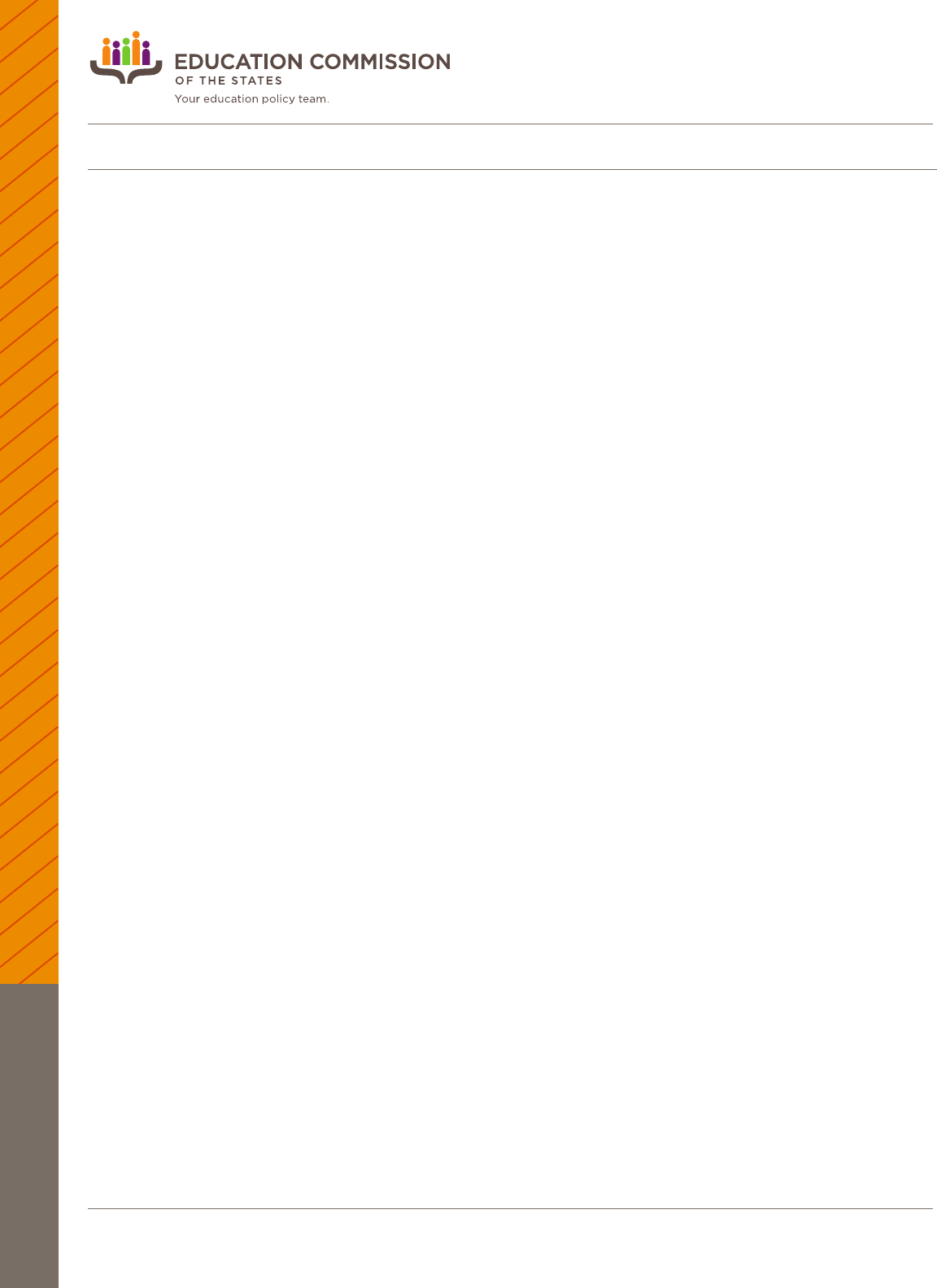
9
POLICY ANALYSIS
www.ecs.org | @EdCommission
Endnotes
1. National Caucus of Native American State Legislators, Striving to Achieve: Helping Native American Students Succeed (National
Conference of State Legislatures, 2008), https://www.ncsl.org/print/statetribe/strivingtoachieve.pdf (accessed August 2, 2016).
2. A note on Native Hawaiian students: Native Hawaiian students are sometimes included in discussions about education for Native
Youth. National statistics on the Native Hawaiian population are not consistently grouped with those of American Indian/Alaska Native
students. As such, we have chosen to limit our discussion in this paper to American Indian/Alaska Native students.
3. National Caucus of Native American State Legislators, Striving to Achieve: Helping Native American Students Succeed (National
Conference of State Legislatures, 2008), https://www.ncsl.org/print/statetribe/strivingtoachieve.pdf (accessed August 2, 2016).
4. Elementary and Secondary Education Act (as re-authorized by ESSA) 6 U.S.C. § 6151 (2016).
5. Bureau of Indian Education, 2016, http://www.bie.edu/index.htm (accessed July 30, 2016).
6. Ibid
7. Executive Oce of the President, 2014 Native Youth Report (December 2014) https://www.whitehouse.gov/sites/default/files/
docs/20141129nativeyouthreport_final.pdf (accessed August 4, 2016).
8. “2011 National Indian Education Study: Summary of National Results,” National Center for Education Statistics http://nces.ed.gov/
nationsreportcard/nies/nies_2011/national_sum.aspx (accessed August 15, 2016).
9. “2011 National Indian Education Study: Regional and State Summary,” National Center for Education Statistics http://nces.ed.gov/
nationsreportcard/nies/nies_2011/national_sum.aspx (accessed August 17, 2016).
10. Ibid
11. Executive Oce of the President, 2014 Native Youth Report (December 2014) https://www.whitehouse.gov/sites/default/files/
docs/20141129nativeyouthreport_final.pdf (accessed August 4, 2016).
12. The Education Trust, The State of Education for Native Student (August 2013) http://edtrust.org/wp-content/uploads/2013/10/
NativeStudentBrief_0.pdf (accessed August 5, 2016).
13. “Public High School Four-Year on-Time Graduation Rates and Event Dropout Rates: School Years 2010-2011 and 2011-2012” National
Center for Education Statistics http://nces.ed.gov/pubs2014/2014391/findings.asp#f5 (accessed August 17, 2016).
14. Executive Oce of the President, 2014 Native Youth Report (December 2014) https://www.whitehouse.gov/sites/default/files/
docs/20141129nativeyouthreport_final.pdf (accessed August 4, 2016).
15. Ibid
16. Elementary and Secondary Education Act (as re-authorized by ESSA) 6 U.S.C. § 6101 (2016).
17. Elementary and Secondary Education Act (as re-authorized by ESSA) 6 U.S.C. § 6101 (2016).
18. Bureau of Indian Education, “Restructuring the Bureau of Indian Education” 2016, http://bie.edu/cs/groups/xbie/documents/
document/idc1-031626.pdf (accessed August 14, 2016).
19. Bureau of Indian Education, “Restructuring the Bureau of Indian Education” 2016, http://bie.edu/cs/groups/xbie/documents/
document/idc1-031626.pdf (accessed August 14, 2016).
20. National Indian Education Association and Alliance for Excellent Education, Every Student Succeeds Act Primer: American
Indian, Alaska Native, and Native Hawaiian Students (Alliance for Excellent Education, June 2016) http://all4ed.org/wp-content/
uploads/2016/06/FINAL-ESSA_FactSheet_NIEA-American-Indian-Students.pdf (accessed August 3, 2016).
21. Ibid.
22. Every Student Succeeds Act, VIII (F)(II)Sec. 8538
23. Every Student Succeeds Act, VI (A)(2 &3) Secs. 6121, 6131
24. Helen S. Apthorp, Where American Indian students go to school: Enrollment in seven Central Region states (Regional Educational
Laboratory and Institute of Education Sciences, 2016) http://ies.ed.gov/ncee/edlabs/regions/central/pdf/REL_2016113.pdf (accessed
August 9, 2016).
25. Utah 53A-31-202
26. Washington RCW 28A.300.105
27. WestEd, Indian Education in Arizona, Nevada, and Utah: A Review of State and National Law, Board Rules and Policy Decisions
(WestEd, 2014) https://westcompcenter.org/wp-content/uploads/2013/11/P6IndED_finalreport_WestEdcomm_cl_9.24.pdf
(accessed August 16, 2016).
28. “Teacher quality and student achievement: Research review,” Center for Public Education, 2005. http://www.centerforpubliceducation.
org/Main-Menu/Stangstudents/Teacher-quality-and-student-achievement-At-a-glance/Teacher-quality-and-student-achievement-
Research-review.html (accessed August 31, 2016).
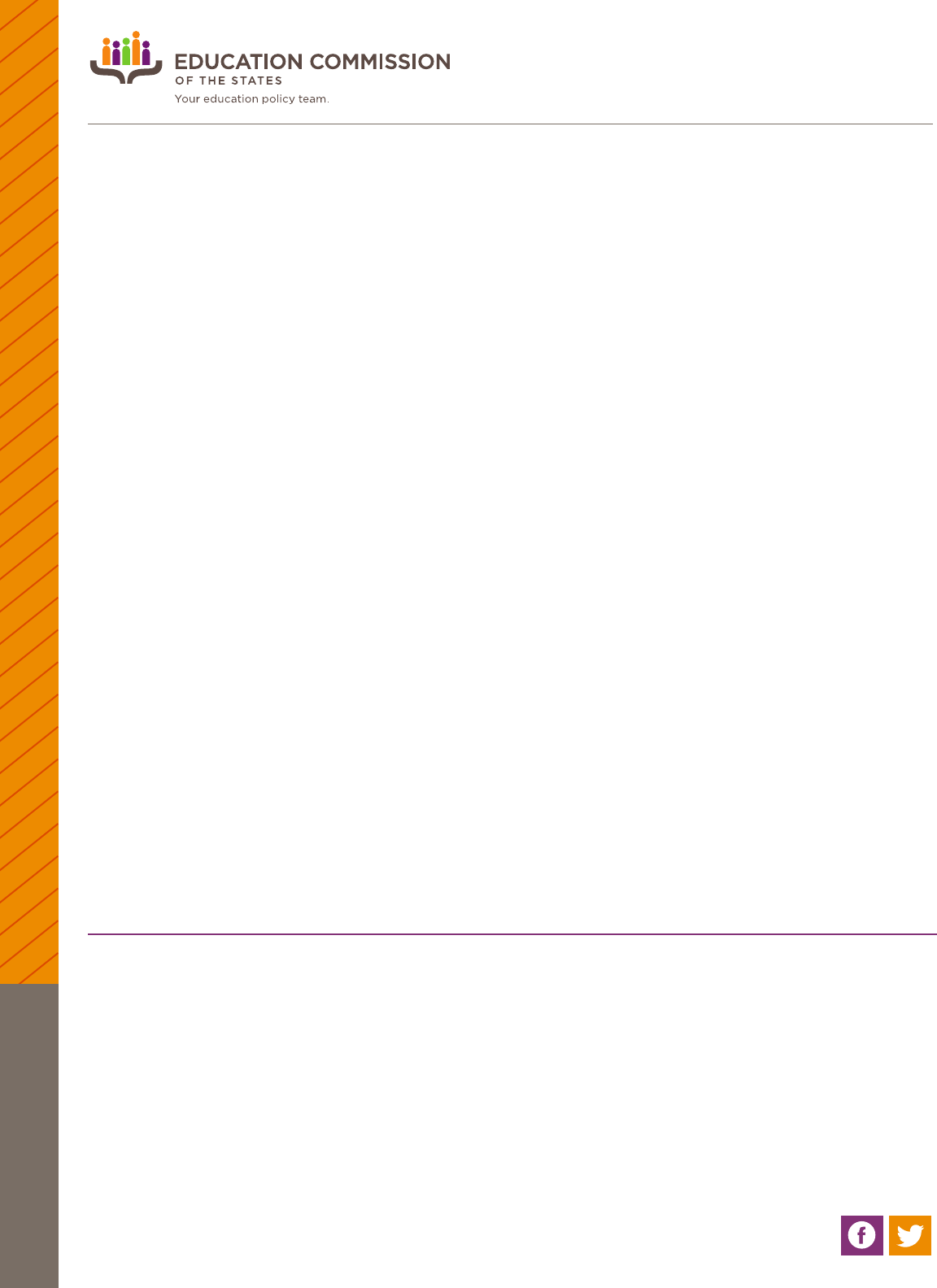
© 2016 by the Education Commission of the States. All rights reserved. Education Commission of the States encourages its readers to
share our information with others. To request permission to reprint or excerpt some of our material, please contact us at 303.299.3609
or email [email protected]g.
Education Commission of the States | 700 Broadway Suite 810 Denver, CO 80203
10
POLICY ANALYSIS
29. Executive Oce of the President, 2014 Native Youth Report (December 2014) https://www.whitehouse.gov/sites/default/files/
docs/20141129nativeyouthreport_final.pdf (accessed August 4, 2016).
30. “2011 National Indian Education Study: Summary of National Results,” National Center for Education Statistics http://nces.ed.gov/
nationsreportcard/nies/nies_2011/national_sum.aspx (accessed August 15, 2016).
31. South Dakota SB 81 (2016)
32. California AB 163 (2016)
33. Utah SB 14 (2016)
34. Angelina E. Castagno & Bryan McKinley Jones Brayboy “Culturally Responsive Schooling for Indigenous Youth: A Review
of the Literature,” Review of Educational Research, vol. 78, no. 4 (2008): 941-993, http://www.mn-indianed.org/docs/
CulturallyResponsiveSchoolingForIndigenousYouth.pdf (accessed August 24, 2016).
35. Montana SB 272 (2015)
36. Oklahoma State Department of Education, Oklahoma Standards for World Languages (Oklahoma State Department of Education,
2015), http://sde.ok.gov/sde/sites/ok.gov.sde/files/2015%20World%20Languages%20Standards.pdf (accessed August 24, 2016).
37. “Alaska Native Language Preservation and Advisory Council” State of Alaska, https://www.commerce.alaska.gov/web/dcra/
AKNativeLanguagePreservationAdvisoryCouncil.aspx (accessed August 25, 2016).
38. “American Indian Languages in Wisconsin,” Wisconsin Department of Public Instruction, http://dpi.wi.gov/amind/language-culture-
education/languages-wisconsin (accessed August 25, 2016).
39. William G. Demmert and John C. Towner “A Review of the Research Literature on the Influence of Culturally Based Education on the
Academic Performance of Native American Students,” Northwest Regional Educational Laboratory (2003) http://educationnorthwest.
org/sites/default/files/cbe.pdf (accessed August 15, 2016).
40. Washington SB 5433 (2015)
41. New Mexico 22-23A-5
42. Arizona ARS 15-710
43. “Budget Justifications and Performance Information Fiscal Year 2017: Indian Aairs” The United States Department of the Interior
(2016) https://www.doi.gov/sites/doi.gov/files/uploads/FY2017_IA_Budget_Justification.pdf (accessed September 21, 2016).
44. “Fiscal Year 2017 Budget Summary and Background Information” United States Department of Education ( 2016) http://www2.
ed.gov/about/overview/budget/budget17/summary/17summary.pdf (accessed September 21, 2016).
45. Lawrence Picus, et al, “An Independent Review of Maine’s Essential Programs and Services Funding”, Lawrence O. Picus & Associates.
April 1, 2013. (accessed September 16, 2016) http://www.maine.gov/legis/opla/EPSReviewPart1(PicusandAssoc%20)4-1-2013.pdf
46. United States Census Bureau
AUTHOR
Alyssa Rafa is a policy researcher in the K-12 institute at Education Commission of the States. She has her
master’s degree in international relations from the University of Denver. Outside of the oce, you can find
Alyssa enjoying the great outdoors with her new husband, Mickey.
Special thanks to Mike Grith for his contribution to the funding section of this paper.
